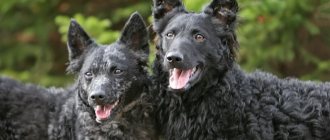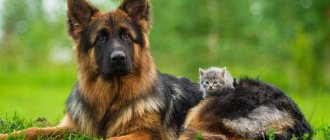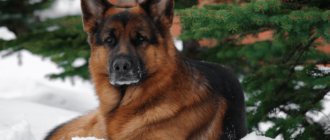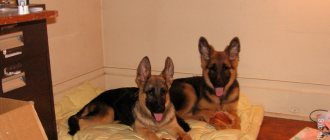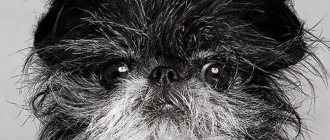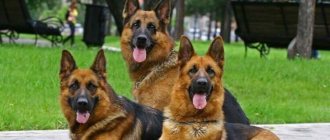The German Shepherd is one of the popular breeds in the world. Every child dreamed of such a dog, because one of the main qualities is their loyalty and intelligence.
This smart dog will easily become the guard of your peace, a faithful comrade, and a brave fighter. It appeals to military personnel, police officers, children, and dog lovers.
Appearance of a German Shepherd dog
The following characteristics can be noted in the description of the German Shepherd:
- Powerful and strong body, wide chest and elongated torso.
- The ears are erect, the muzzle is long and black.
- Classic color - Black or gray with a slight reddish tint.
The variety of animal colors can be seen in the photo of the German Shepherd.
Acceptable colors: names and photos
According to the standard, 3 types of colors are possible for a purebred German Shepherd: black-and-white, zoned and black. Black and tan is distinguished separately, but it cannot be positioned as an independent type. This suit is just a variation of the main colors.
Cheprachny
The most common type, found in 90% of individuals. Such dogs have a V-shaped black spot on their back, which extends to the sides, belly, top of the tail and can extend to the elbows. The bottom is light in color. It grabs the stomach, chest, neck, paws. Various shades are allowed:
- fawn (yellow);
- grey;
- brown (chocolate).
A prerequisite is a black mask. It covers the animal's face and ears. Defects are considered to be the absence of a mask, if it is weakly expressed, or a “saddle blanket” of a desaturated color. The shade of tan can be any, but darker tones are preferable.
When buying a black-backed puppy from a kennel, you must take into account that it will become lighter in color with age.
Zonar
Considered a rare type. Only 5% of “Germans” have this suit. The color arises from the interesting color of the coat: it is light at the base, then dark, then yellow, and black at the tips.
The zone suit is also called wolf, grey, gray or agouti.
The muzzle, back and tail are the most intensely colored. Saturation weakens on the sides and on the paws.
Any shades are acceptable - from rich brown to light yellow. But under one condition: the structure of the color should not be disturbed.
The zonal color gene is always dominant. It is curious that it is impossible to get a puppy of this color if you cross two “zonars” - the babies will be black or black.
Black
The name speaks for itself. These “Germans” have a luxurious all-black fur coat.
This is the rarest variety provided for by the standard. According to various sources, it occurs in only 3% to 5% of dogs.
A deviation is considered to be an inclusion of any other shade. White spots, markings, light nails and nose are not allowed. If the puppy is born with a completely black coat, its color will not change during shedding.
Black and Tan
It is sometimes distinguished as a separate type, but in fact it is a variety of other suits. A dog with this color will be almost black, with the exception of brownish-red patches on the belly and on the inside of the paws. Light eyebrows, chest and cheekbones are also allowed.
Unlike pure black, dark tan can lighten over time. In addition, it weakens from litter to litter.
Caring for a German Shepherd
Four-legged friends shed in spring and autumn, so the owner needs to purchase special brushes and combs to care for the pet’s coat.
Walk the dog at least 2 times a day (more is better): Half an hour in the morning and 2 hours in the evening. They are very active animals and need full physical activity.
Dogs live for about 12 years, but some individuals can live up to 18.
Origin story
The German Shepherd traces its ancestry back to breeds that guarded sheep in Germany. These were unique service mammals - fast, efficient and manageable. But the breeders were unable to create a single breed.
- In 1980, Max von Stephanitz decided to tackle this issue. He was educated and knew the laws of heredity well.
- On April 3, 1899, Stefanitz and his friend visited a dog show, where they noticed a yellow-gray male the size of a wolf. Hector Linkerhein was his name. The four-legged owner told them about his innate inclination to serve and his high efficiency. And Stefanitz bought a male dog for his kennel.
- In the same year, his friend Arthur Meyer created the official “Union of German Shepherd Owners,” where a single book of the breed was kept. To preserve the individual qualities of the coat, Stefanitz organized competitions where the main criterion was the training of the German Shepherd. A little later, the breeder organizes exhibitions where prizes are given not for external characteristics, but for the ability to serve a person.
Max von Stefanitz studied this breed for 36 years. His dream was to create an international union of German Shepherd breeders. But in the 30s, the spread of national views began in Germany, and the authorities did not allow the creation of this association, threatening a concentration camp. And on April 22, 1936, Stefanitz passed away.
Nutrition
German Shepherds are classified as large dogs. In terms of proportions, their digestive tract is much smaller than that of small-sized suits.
- To avoid digestive problems, you need a special diet.
- We select food based on weight and age, and always for large dog breeds.
- Don't forget about the drinking regime: there should always be water in the bowl.
Adults should eat 2 times a day.
About Belgian Malinois - Overview
These canine friends were originally bred as herding dogs. Today, the Belgian Malinois is active as a guard dog, police dog, and friendly family companion. This energetic and athletic dog is short-haired and light brown in color. Originally bred in Malines, Belgium, the dog breed has great endurance and excels at many tasks.
In addition to police work, herding, and search and rescue work, the Belgian Malinois is also a top contender for sporting competitions, including agility. People unfamiliar with the dog breed often confuse them with German Shepherds. Malinois are sensitive dogs and do not respond well to harsh training methods. Therefore, dog owners are advised to remain patient and persistent during training.
What to feed?
- Cereals cooked in water: rice, buckwheat, less often oats and barley, peas and pearl barley - exclude.;
- It is better to give fresh meat from 600 to 800 grams per day;
- Dry food.
Large dogs do not have new teeth, so bones should not be given. You can purchase a special bone. It is forbidden to feed the animal food from your table!
Buying a puppy
Buying a puppy is a very joyful and exciting moment. After all, a person takes responsibility for a fragile living being. German Shepherd puppies, like other pets, require proper care, attention and training.
Before you make a little friend, think carefully: do you need him?! Do you have enough free time, are there enough funds for maintenance, and is there room in the house or apartment for it?
Exercises and workouts
Both dog breeds are very energetic and suitable for outdoor activities. Energetic dogs should not be left idle for long periods of time. Taking your pet on long walks and allowing him to spend time outdoors can improve his mental and physical health. It is important to keep your dog occupied with various activities, otherwise he may exhibit destructive behavior such as barking and chewing.
Both are super smart dogs and incredibly trainable dogs in the right hands.
Just because a dog can be trained does not mean it is suitable for first-time owners. These dogs need experienced owners who understand how to train them and what they will respond to.
They respond to positive reinforcement and reward-based learning. Avoid aversion techniques at all costs, even if they are large breeds. It is well known that punishment causes and worsens problem behavior.
Dogs learn from the consequences of their behavior.
If they have positive consequences, they are more likely to repeat the behavior. If they don't behave the way you want them to, ignore and redirect or reward the behavior you want to see then reward/praise them.
READ: Can a pit bull live with another dog? — Why are pit bulls so aggressive?
Mind games will be a lifesaver to keep those active minds busy, especially in Malinois:
Try this: Hide and Search .
- Starting while he is in the same room as you, have someone hold his collar or obey the "stay" command.
- Hide treats or toys in the room, behind a pillow, behind a curtain (safe places that are easily accessible).
- Say the word "search" and ask your assistant to release it.
- Encourage him to seek out toys/treats.
- Play in different rooms or in the yard.
The key to raising a well-rounded and stable dog, whether it's a German Shepherd or a Malinois, is early and consistent socialization.
Introduce them at a young age to something they will encounter regularly.
Historical workers and custodians are naturally wary of strangers and need to know what is safe.
Well socialized Shepherds and Malinois are stoic and fearless.
Girl or boy
Girls of this color are easier to train; they are flexible and kind. And don’t forget about the troubles associated with the birth of her cubs.
Males are active, independent, always ready to work. They are often kept by hunters. Boys are valued as service dogs.
Eye and skin colors
The breed standard states that the iris should be as dark as possible. Black eyes are expressionless, especially against the background of the mask.
The iris is not a determining sign in culling a dog. Pigmentation may contrast with the coat. Some breeders give preference to individuals whose iris color matches the general color scheme.
The lining of the mucous membrane in pets with a dim color is saturated, spotting is noted on the mucous membrane of the tongue. The skin is blue-gray, in areas where the coat is bleached it is pinkish, like the ears and anus, with the exception of dark-coated dogs.
Standards
The eyes are medium-sized, oval, almond-shaped, slightly obliquely spaced, shallow-set. The iris ranges from light brown, blue, to dark brown.
The color of the coat is not related to the color of the eyes. According to the requirements, the skin is ashy with a bluish tint, in reddish-yellow places it is pink, and does not form folds.
Deviations
A very light color of the iris is considered a breed fault. Heterochromia and yellow iris are not accepted. These appearance features do not pose a health hazard, but they distance the animal from the breed ideal.
The round shape of the eyeball, deep seating are disqualifying signs. Hanging folds of skin located on the neck are a deviation from the breed.
Tips for choosing puppies
- Take puppies from a litter where 4-6 individuals are left to raise;
- Give preference to a pet in whose pedigree several generations have had high qualities;
- The puppy should be 40-50 days old;
- Spring or summer is the best time to buy a man's friend;
- Buy from special nurseries where all mating rules are followed.
How much does a German Shepherd cost? is an important question for a dog buyer.
- In our country, the price varies from 3,000 to 650,000 rubles.
- On average, German Shepherd puppies cost around 25-35,000.
- The best German shepherds with a detailed pedigree will cost from 50,000 rubles or more.
Training
This breed is highly trainable for any purpose. Be it a guide dog or a bloodhound. The main thing is to start studying with the “German” on time. They learn new commands well: in just 5 repetitions.
German Shepherd training begins at the age of 10 months.
Training rules
- The dog must distinguish the intensity of the timbre of the owner’s voice: affectionate, order and threat.
- Contrast in intonation: if the little friend does not follow the command, then the order sounds harsher.
- Training techniques should be short and identical.
- Commands (ugh, voice, sit, stop, lie down, etc.) are carried out during a walk with encouragement, treats and praise from the owner (“good,” well done, etc.)
- Compulsion. The owner can force the dog to follow a command. For example, if the kitten does not comply with the command “Sit!”, then the owner presses his hand on his sacrum.
Character and temperament
The character of the German Shepherd can be called ideal.
Purebred healthy shepherd dogs do not have negative character traits, they are always ready to help, do not lie idle and are happy to keep company on a walk or during military service.
Such dogs have a high threshold of excitability: they do not enter into conflicts and do not show aggression towards strangers, but they always react in a timely manner if the owner or his loved ones are in danger.
The German Shepherd cannot do without human company . Left alone, she begins to feel sad and can only be distracted by completing any task (for example, guarding a site). The brave animal will happily begin to fulfill its duty.
The dog is very smart and quick-witted, capable of constantly learning new things. In addition, German Shepherds are talented actors who have played many roles in films.
Vaccination. Congenital diseases
Vaccination is an important step that should not be ignored by any dog owner.
What diseases are you required to vaccinate against?
- Rabies (once a year);
- Plague of carnivores;
- Parvovirus (intestinal) infection;
- Leptospirosis.
Most vaccinations are given to animals up to a year old to protect puppies from diseases and infections.
German Shepherds are a strong and healthy breed, but they have “weak points” - the hip joints, which are prone to dysplasia. This is a hereditary disease. When purchasing a puppy, ask for documents that will confirm that the parents do not have this disease.
Prevention of dysplasia in large dogs
- From birth to 4 months, limit your pet’s physical activity;
- Control your diet (excess weight is a risk for developing the disease; food should be rich in vitamins and minerals);
- Properly distribute physical activity according to the age of the individual.
Deviations from the color standard
All other colors are considered a defect of the breed. Such pets are not allowed for exhibitions and are not suitable for breeding. However, unusually colored pets are expensive and are valued among owners for their uniqueness, since deviations from exterior characteristics are rare among “Germans”.
Red (yellow)
Red (yellow) color
The coat is colored red. This variation should not be confused with the zonal red, which is the standard. Rejected dogs come in many shade combinations from fiery to light yellow. There is no saddle cloth or mask on the face.
Grey
Gray color
The color appears as a result of a mutation that weakens the influence of gene A. It is called asphalt, “silver”, blue. Characterized by significant lightening of the fur on the belly, paws, and chest. Sometimes their irises brighten.
Gray-blue individuals look attractive, but are not involved in mating. However, American breeders are trying to breed asphalt “Germans” with amber irises.
Golden
Golden color
A variety of yellow color. The difference is that the fur is even lighter, and a separate bright pigment is responsible for this. On the belly and inner thighs the coat is almost white, with a beige or dirty yellow undertone.
In the sun the hair shines gold. Dark tones predominate on the face, and a barely visible mask is characteristic.
Spotted
Spotted color
The base is white, with spots of brown and reddish color scattered on it in a chaotic manner. The spots do not have clear shapes and can be either very large or small.
Spotting is not caused by mutation, but by crossing with outbred dogs or with Australian Aussies, which are characterized by the presence of a variety of spots.
Roan
Roan Coat Color
Roan coat color is not a separate species. Age-related changes affect the pigment of the hair, it gradually disintegrates, and the hair turns grey.
When gray hair spreads over a larger area than the main color range, the color is called roan. This process occurs most often in older pets.
White
White color
White color appears when two recessive genes coincide in a dog, which happens very rarely. Light colored individuals are highly valued, although they are rejected by the breed standard. It is believed that they are very flexible, more family-oriented and gentle.
White “Germans” are not albinos; the albinism gene is not characteristic of them. Albinism is a disease in which the formation of the melanin pigment is impaired. It is responsible for the coloring of hair, irises, and claws.
Albinos have blue or pink eyes and a pinkish nose. With white coloring, the pigmentation of the nose and eyes is preserved. Animals of this color do not have concomitant diseases characteristic of albinos: hearing impairment, vision impairment, photophobia.
We recommend reading:
- How many years do German Shepherds live, life expectancy in different conditions and how it can be influenced.
- Rating of dogs by intelligence, find a German Shepherd there and you will be very surprised.



